Giselle
Powerful, Radical, Memorable
Giselle
by Akram Khan, music by Vincenzo Lamagna, after Adolphe Adam
English National Ballet at Sadler’s Wells until 28th September, then on European tour until 18th July
Review by Mark Aspen
Walls, walls that contain, walls that exclude have made potent socio-political statements throughout history from Hadrian’s Wall or the Berlin Wall to modern divides such as those in Israel or along the Mexican-USA border. Such a wall is the overarching presence in Akram Khan’s Giselle, first produced three years ago by the English National Ballet, and now vigorously revived for a ten-month tour of Europe, opening at Sadler’s Wells.
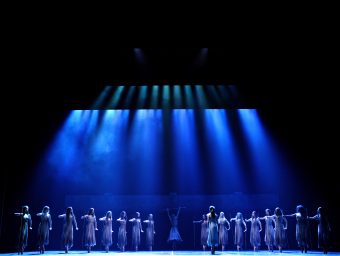 Khan has reworked the 1841 romantic ballet with dramaturg Ruth Little into a topical parable of today’s displaced peoples. It is set outside of an abandoned clothing factory, from which its former workers (the Outcasts) are excluded, shut off from employment or return to their own dispersed communities. Beyond the wall, which divides society, wealth from poverty, the Landlords live in luxury.
Khan has reworked the 1841 romantic ballet with dramaturg Ruth Little into a topical parable of today’s displaced peoples. It is set outside of an abandoned clothing factory, from which its former workers (the Outcasts) are excluded, shut off from employment or return to their own dispersed communities. Beyond the wall, which divides society, wealth from poverty, the Landlords live in luxury.
From its thunderously dramatic opening with its overwhelming heartbeat music, this is a piece that packs some punch. Full of energy and dark excitement, the tension and threatening nature of the story is retold in a way that takes it far away from the 1841 chocolate box ballet to something much deeper and intense. The imaginative imagery embraces the setting, the music and of course the dance.
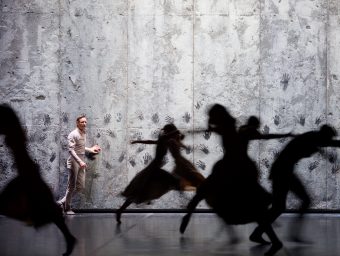 The setting, by designer Tim Yip, whose concept for the Beijing handover ceremony at the close of the Athens Olympics brought international recognition, has a clear feel for the monumental, and his Giselle design paradoxically combines large scale with a feeling of claustrophobia. Mark Henderson’s moody lighting underlines this dichotomy. Yip’s costume design starkly contrasts the Outcasts and the Landlords, plain shifts of the woman workers with the exotic dresses of their wealthy counterparts. The latter lifts the period from the topically of the present into an indeterminate unworldliness of all-time (witness the phantasmagoric pannier dress of one of the ladies).
The setting, by designer Tim Yip, whose concept for the Beijing handover ceremony at the close of the Athens Olympics brought international recognition, has a clear feel for the monumental, and his Giselle design paradoxically combines large scale with a feeling of claustrophobia. Mark Henderson’s moody lighting underlines this dichotomy. Yip’s costume design starkly contrasts the Outcasts and the Landlords, plain shifts of the woman workers with the exotic dresses of their wealthy counterparts. The latter lifts the period from the topically of the present into an indeterminate unworldliness of all-time (witness the phantasmagoric pannier dress of one of the ladies).
The music is just as innovative in its synthesis of sources and styles. Composer Vincenzo Lamagna’s score is sit-up-in-your-seat powerful. Its opening impact is almost overpowering, fully illustrative of the power of the Landlords over the Outcasts, metaphorical chains and whips. However, Lamagna uses silence to equally impressive potency. Between, the motifs of Adolphe Adam’s original score percolate like primeval reminiscences. Adams contemplative lyricism mainly accompanies the pas de deux of Giselle and Albrecht, a solo cello when they meet in the underworld and a plaintive oboe when Giselle’s spirt is given up for ever. All this makes for a busy time in the orchestra pit, and the English National Ballet Philharmonic under conductor Orlando Jopling deliver an impassioned and energetic rendering of Gavin Sutherland’s orchestration.
Then there is the imagination in the dance. Akram Khan’s trademark fusion of contemporary dance with both classical ballet and the Kathak patterns of his Bengali heritage leads to a remarkably enthralling experience.

Khan’s concept takes the romantic ballet of 1841, peasants and aristocrats in a mediaeval Rhineland, into a much more totalitarian world. In Act I, the class divide becomes the physical barrier of the wall; the vicissitudes of the harvest becomes the factory closure; the gamekeeper, Hilarion becomes a predatory overseer; and the disguised grandee Albrecht becomes a 21st Century HRH mingling with the masses. Act II remains ethereal, but the forest glade haunted by Wilis, the spirits of jilted brides, becomes a ghost factory populated by the malign spectres of women workers killed in industrial accidents; while Myrtha, the Queen of the Wilis, becomes even more merciless and vindictive.
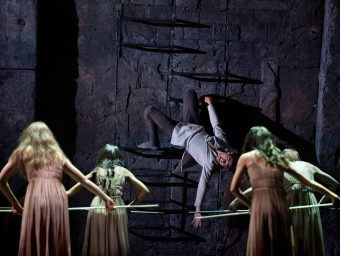 The hard-edged approach to the concept allows for an expansive mixed palette of choreography. It is percussive at its opening, then broadens to show the migrants’ plight through the metaphor of the movement of fleeing animal herds. The palette ranges from hints at the popping and locking of hip-hop to the more fluent forms of folk-dance. The lyrical pas de deux are pure classical ballet, and in Act II Khan, very atypically, uses extensive pointe work. In fact, the corps de ballet spend most of Act II en pointe, increasing the demands on them in an already difficult ballet. But the effect is mesmerising, as they move in numerous pas de bourrée, fluttering across the stage with a fragile lightness. However, Khan’s Wilis are far from fragile, they are terrifying! They goad Hilarion viciously to death, are unremitting with the pleading Giselle, and abandon a broken Albrecht with a chilling heartlessness. Moreover the Wilis come armed, literally to the teeth, with slender rods, symbolic of punishment and of authority, but these have been the battens of the dilapidated power looms. Their ensemble entrance, with its accompanying music, is a recreation of the working factory loom: a brilliant double edged metaphor.
The hard-edged approach to the concept allows for an expansive mixed palette of choreography. It is percussive at its opening, then broadens to show the migrants’ plight through the metaphor of the movement of fleeing animal herds. The palette ranges from hints at the popping and locking of hip-hop to the more fluent forms of folk-dance. The lyrical pas de deux are pure classical ballet, and in Act II Khan, very atypically, uses extensive pointe work. In fact, the corps de ballet spend most of Act II en pointe, increasing the demands on them in an already difficult ballet. But the effect is mesmerising, as they move in numerous pas de bourrée, fluttering across the stage with a fragile lightness. However, Khan’s Wilis are far from fragile, they are terrifying! They goad Hilarion viciously to death, are unremitting with the pleading Giselle, and abandon a broken Albrecht with a chilling heartlessness. Moreover the Wilis come armed, literally to the teeth, with slender rods, symbolic of punishment and of authority, but these have been the battens of the dilapidated power looms. Their ensemble entrance, with its accompanying music, is a recreation of the working factory loom: a brilliant double edged metaphor.

Lead Principal Fernanda Oliveira as Giselle dances with a light and delicate liquidity, the character’s naivety overshadowed by her hopeful and loving nature: a joy to watch. Giselle has fallen in love with the noble-born Albrecht, who has infiltrated the Outcasts in disguise. Aitor Arrieta makes an imposing Albrecht, bringing something of his native Basque country’s fire and determination to his unflaggingly energetic dancing. Their wooing scenes are full of tenderness.
The lovers are however thwarted by the cunning Hilarion, who also has designs on Giselle, which go unrequited. Hilarion, as the de facto go-between for the Outcasts and Landlords, is an ambiguous presence, hunting with the hounds and running with the hare. Khan describes him as “a shape-changing fixer”, lining his own pockets. In the role of Hilarion, Erik Woolhouse fills the part with a muscular athleticism, aerial yet grounded at the same time. Woolhouse is a remarkable dancer with enormous potential. (He was awarded Young British Dancer of the Year when still student.)
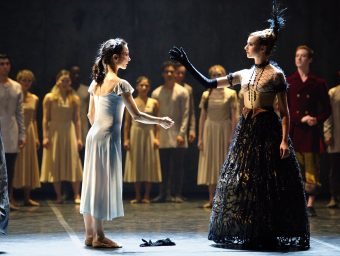 The sudden arrival of the Landlords, announced by a broken factory hooter, is a moment of remarkable theatre as the massive wall pivots and we see its gold-plated far side. Their entrance is stately, glamourous yet unnervingly bizarre. Amongst them is Bathilde, the heiress daughter of a duke, to whom Albrecht is betrothed, and Albrecht is exposed as a duplicitous two-timer. Giselle recognises Bathilde’s evening dress, a (not-so)-little black number, as her own handiwork. Bathilde’s reaction to the hurt Giselle feels is one of pure distain. Stina Quagebeur as the aloof Bathilde certainly knows how to put across an emotion by pure body image. She peels off a long formal glove and, before Giselle’s eyes let it drop on the floor. When coerced to choose, Albrecht takes money and status, rather than love and fidelity.
The sudden arrival of the Landlords, announced by a broken factory hooter, is a moment of remarkable theatre as the massive wall pivots and we see its gold-plated far side. Their entrance is stately, glamourous yet unnervingly bizarre. Amongst them is Bathilde, the heiress daughter of a duke, to whom Albrecht is betrothed, and Albrecht is exposed as a duplicitous two-timer. Giselle recognises Bathilde’s evening dress, a (not-so)-little black number, as her own handiwork. Bathilde’s reaction to the hurt Giselle feels is one of pure distain. Stina Quagebeur as the aloof Bathilde certainly knows how to put across an emotion by pure body image. She peels off a long formal glove and, before Giselle’s eyes let it drop on the floor. When coerced to choose, Albrecht takes money and status, rather than love and fidelity.
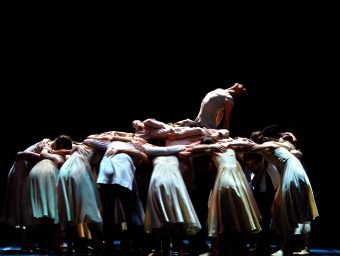 Khan’s Kathak style elements come into their own in the inactions of empathy of the Outcasts to Giselle, at first in the vibrant dance patterns as they rejoice with her in her finding love with Albrecht and now in a swooping whirl of sympathy with the distraught Giselle. As an ensemble, the Outcasts spiral around as one protective organism as she succumbs to death, traditionally of a broken heart, but here aided by a mimed overdose. The undulating whorl is a visually powerful image of the embrace of love in death.
Khan’s Kathak style elements come into their own in the inactions of empathy of the Outcasts to Giselle, at first in the vibrant dance patterns as they rejoice with her in her finding love with Albrecht and now in a swooping whirl of sympathy with the distraught Giselle. As an ensemble, the Outcasts spiral around as one protective organism as she succumbs to death, traditionally of a broken heart, but here aided by a mimed overdose. The undulating whorl is a visually powerful image of the embrace of love in death.
The different feel of Act II is powerfully enhanced in this Giselle, as the corps de ballet transmogrify from the supportive but downtrodden Outcasts into the vengeful and implacable Wilis. Isabelle Brouwers’ Myrtha, the Wilis Queen, fairly drips with malice and callousness, exerting her unbending control on Giselle, truly the psychopath to make you shiver.
Giselle may be pliant to the whims of successive choreographers, but Khan’s radical retelling has already set itself as a definitive modern version, as powerful as it is memorable.
Nevertheless, one need not take a mere critic’s view. At the Saturday matinee, which this critic attended, a couple leaving after the final curtain were overheard: “I’d like to see that again”. “So would I: let’s go to the box-office to see if they have any tickets for tonight”. I was tempted to join them.
Mark Aspen
September 2019

Trackbacks & Pingbacks